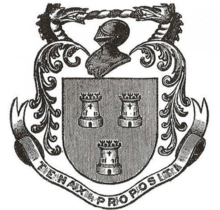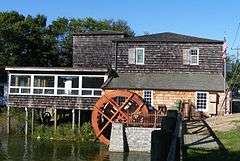Edward Howell (died 1655)

Edward Howell, Gent. (1584–1655),[1][2][3][4][5][6][7][8] born in Marsh Gibbon, Buckinghamshire,[5][6][8] was an English Puritan who settled at Lynn, Massachusetts in 1635.[1][2][3][4][5][6][8] He was known for the founding of Southampton, New York[1][2][3][4][5][7][8] with Thomas Halsey in 1639/40.[5][9]
Early life and immigration to New England
.png)
Edward Howell was baptized on 26 July 1584 at Marsh Gibbon, Buckinghamshire, England.[1][3][4][5][6] He was son of Henry Howell, Gent. and Margaret Hawten (Haughton/Houghton)[1][3][4][6][8][11] and heir to Westbury Manor.[1][3][4] Howell and his family (see below) immigrated to Boston c. 1635,[1][3][4][5][6] where they first settled at Lynn, Massachusetts, where they were one of the four largest landowners.[1][3][4][6][12] In 1638, he sold Westbury Manor to Richard Francis.[4] On 14 Mar 1638/39, he took the oath as Freeman in Boston, Massachusetts[1][3][4][8] where he received 500 acres at Lynn.[1][3][4][8]
Founding of Southampton, Long Island, New York

During the winter of 1638/40, a new settlement was projected on Long Island, New York, of which Edward was the leader.[8] The agreement, or term, of this new settlement, which is still in existence in the Southampton Town Clerk's Office, is believed to be in Edward's own handwriting.[8] In 1640 the Howell family removed permanently to Southampton, Long Island, New York, first settling at "Old Town", and then in 1648, at what is now the current village of Southampton (New York).[1][3][4] The original founders, or "undertakers" as they were then called, of Southampton were: Edward Howell; Edmund Farrington; Josias Stanborouh; George Welbe; Job Sayre; Edmund Needham; Henry Walton; Daniel How; John Cooper; Allen Bread; William Harker; Thomas Halsey; Thomas Newell; John Farrington; Richard Odell; Phiip Kyrtland; Thomas Farrington; and Thomas Terry.[12] He took a leading role in the affairs of Southampton, serving in many capacities there an in Connecticut, of which Southampton became a part following a request made by himself and two others 25 October 1644.[3][4] He served as magistrate in Southampton[8] until 1653 and Assistant of the Connecticut Colony from 1647 to 1653.[3][4] The original settlement, called "Mecox", was a name taken from the Shinnecock Indians for "flat or plain country."[13] Howell announced that he would build a mill for the grinding of grain, rye and wheat into flour. The colonists expected him to build a wind mill but Howell instead chose an area of land that allowed for a stream to power the mill (one which empties into the present Mecox Bay).[13] Nearly four hundred years later, Howell's Water Mill still stands in present-day Water Mill where it was listed on National Register of Historic Places in 1983.[14] For one hundred and fifty years, the Howells were the most extensive landowners, the largest taxpayers and held the highest offices.[8]
Family
Edward Howell married (1st) at Odell, Bedfordshire, England[1][13] Frances Paxton[6][8][13] on 7 April 1616 (d. 1630).[1][3][4][5][6][13][15] They had four sons and three daughters:[1][3][4][13]
- Henry Howell[1][6][8][13] (bapt. 2 Dec 1618, bur. 29 Aug 1619)[8]
- John Howell[1][6][8][13] (bapt. 24 Nov 1622)[8]
- Edward Howell[1][6][8][13] (bapt. Sep 1626)[8]
- Richard Howell (bapt. 1629, d. aft. 1698)[8][13] m. Elizabeth Halsey (dau. of Thomas Halsey of Hertfordshire, England & founder of Southampton, New York)[1][3][5][6][8][13][15]
- Dorothy Howell[1][6][8]
- Margaret Howell[1][6][8] (bapt. 24 Nov 1622)[8] m. Rev. John Moore of Southold, Long Island
- Margery Howell[1][6][8] (bapt. 1 Jun 1628)[8]
He married (2nd) Eleanor (before 1632).[1][6][8][15]
Death
Edward Howell died shortly before 6 October 1655[1][2][3][4][6][8] and was buried in the Southend Cemetery,[3][4][8] Southampton, Long Island, New York.[8] In 1657, his widow. Eleanor, was granted 20 shillings in compensation for her house being burned by a Native tribe.[3][4] She married (2nd) before 14 March 1663 Thomas Sayre.[3][4]
Ancestry
Edward Howell is a direct descendant, through his maternal line (Hawten/Houghton/Haughton), of the royal House of Plantagenet,[4] the House of Arundel (Fitz Alan)[3][4] and Magna Carta Barons[3] Saer de Quincy, 1st Earl of Winchester[3] and Robert de Vere, Earl of Oxford.[3]
In Douglas Richardson's Plantagenet Ancestry: A Study in Colonial and Medieval Families (2nd Ed.) Edward Howell's descent from King John "Lackland" of England is proven as follows:[2][3][4]
- John of England m. Clemence[4]
- Joan, Lady of Wales m. Llewelyn "The Great" ap Iorwerth, Prince of North Wales[4]
- Gwladus Ddu of Wales (dau. of Llywelyn ab Iorwerth) m. Ralph de Mortimer[4]
- Roger de Mortimer, 1st Baron Mortimer m. Maud de Braose (Brewes)[4]
- Isabella Mortimer, Lady of Clun & Oswestry m. John FitzAlan, 7th Earl of Arundel, Sussex, Clun & Oswestry[4]
- Richard FitzAlan (de Arundel), Knt., 8th Earl of Arundel m. Alice of Saluzzo[4]
- Edmund FitzAlan de Arundel, 9th Earl of Arundel m. Alice de Warenne (desc. of Geoffrey Plantagenet, Count of Anjou)[4]
- Richard FitzAlan de Arundel ("Copped Hat"), 10th Earl of Arundel & Surrey[3][4]
- Ralph de Arundel m. Juliane[3][4][16][17]
- Alice de Arundel m. Bartholomew Collingridge (Colyngrygge)[3][4][16][17][18]
- William Collingridge m. Sarah[3][4][16][17][19]
- Alice Collingridge m. Geoffrey Dormer[1][3][4][19][20]
- Alice Dormer m. Thomas Crocker (Croker)[1][3][4][20][21]
- John Crocker m. Isabel Skinner[1][3][4][20][21]
- Margery Crocker m. Edward Hawten of Swalcliffe, Epwell and Hook Norton[1][3][4][20][21]
- Margaret Hawten m. Henry Howell, Lord of Westbury (Marsh Gibbon)[1][3][4][6][11]
- Edward Howell, Lord of Westbury[1][3][4][6]
In Douglas Richardson's Magna Carta Ancestry: A Study in Colonial and Medieval Families (2nd Ed.) Edward Howell's descent from Magna Carta Barons Saer de Quincy, 1st Earl of Winchester and Robert de Vere, Earl of Oxford, is proven as follows:
- Robert de Vere, 3rd Earl of Oxford m. Isabel de Bolbec, Countess of Oxford[3]
- Hugh de Vere, 4th Earl of Oxford m. Hawaise de Quincy (dau. of Saer de Quincy, Magna Carta Baron)[3]
- Robert de Vere, 5th Earl of Oxford m. Alice de Stanford[3]
- Joan de Vere m. William de Warenne[3]
- Alice de Warenne (desc. of Geoffrey Plantagenet, Count of Anjou)[4] m. Edmund FitzAlan de Arundel, 9th Earl of Arundel[3]
- Richard FitzAlan de Arundel ("Copped Hat"), 10th Earl of Arundel & Surrey[3][4]
- Ralph de Arundel m. Juliane[3][4][16][17]
- Alice de Arundel m. Bartholomew Collingridge (Colyngrygge)[3][4][16][17][18]
- William Collingridge m. Sarah[3][4][16][17][19]
- Alice Collingridge m. Geoffrey Dormer[1][3][4][16][19][20]
- Alice Dormer m. Thomas Crocker (Croker)[1][3][4][20][21]
- John Crocker m. Isabel Skinner[1][3][4][20][21]
- Margery Crocker m. Edward Hawten of Swalcliffe, Epwell and Hook Norton[1][3][4][20][21]
- Margaret Hawten m. Henry Howell, Lord of Westbury (Marsh Gibbon)[1][3][4][6][11]
- Edward Howell, Lord of Westbury[1][3][4][6]
References
- 1 2 3 4 5 6 7 8 9 10 11 12 13 14 15 16 17 18 19 20 21 22 23 24 25 26 27 28 29 30 31 32 33 34 35 36 37 38 39 Faris, David (1985). Descendants of Edward Howell (1584-1655). Baltimore, MD: Gateway Press. pp. 8–9, 12, 15, 38, 47–48.
- 1 2 3 4 5 Faris, David (1985). Descendants of Edward Howell (1584-1655) of Westbury Manor, Marsh Gibbon, Buckinghamshire, and Southampton, Long Island, New York. Baltimore, MD: Gateway Press. pp. 8–9, 12, 15, 38, 47–48,.
- 1 2 3 4 5 6 7 8 9 10 11 12 13 14 15 16 17 18 19 20 21 22 23 24 25 26 27 28 29 30 31 32 33 34 35 36 37 38 39 40 41 42 43 44 45 46 47 48 49 50 Richardson, Douglas (2011). Magna Carta Ancestry: A Study in Colonial and Medieval Families (2nd Ed.). Salt Lake City, UT. pp. 418–426. ISBN 978-1-4610-4520-5.
- 1 2 3 4 5 6 7 8 9 10 11 12 13 14 15 16 17 18 19 20 21 22 23 24 25 26 27 28 29 30 31 32 33 34 35 36 37 38 39 40 41 42 43 44 45 46 47 48 49 50 51 Richardson, Douglas (2011). Plantagenet Ancestry: A Study In Colonial And Medieval Families (Vol. 1, 2nd Ed.). Salt Lak City, UT. pp. 280–285. ISBN 9781461045137.
- 1 2 3 4 5 6 7 8 9 Howell, George Rogers (1887). Early History of Southampton, Long Island, New York, with Genealogies (2nd Ed.). Albany, NY: Weed, Parsons and Company. pp. 300–301.
- 1 2 3 4 5 6 7 8 9 10 11 12 13 14 15 16 17 18 19 20 21 22 23 24 25 Effingham, Humphrey P. (1984). "Descendants of Edward Howell". The Genealogist. 5 (1): 3–5, 9–10.
- 1 2 Hedges, H.P. (1874). The First Records of Records of Southampton with Other Ancient Documents of Historic Value. Sag Harbor, New York: John Hunt, Publisher.
- 1 2 3 4 5 6 7 8 9 10 11 12 13 14 15 16 17 18 19 20 21 22 23 24 25 26 27 28 29 30 31 32 33 Pelletreau, William S. (1907). Historic Homes and Institutions and Genealogical and Family History of New York (Vol. 1). New York, Chicago: The Lewis Publishing Company. pp. 308–312.
- ↑ Halsey, Jacob Lafayette (1895). "Thomas Halsey of Hertfordshire, England, and Southampton, Long Island, 1591-1679: With His American Descendants to the Eighth & Ninth Generations". The Jerseyman Office. pp. 38, 44.
- ↑ Page, William (1908). Victoria History of the County of Buckingham. London, England: Archibald Constable and Company Ltd.
- 1 2 3 Plowden, Edmund (1816). The commentaries, or Reports of Edmund Plowden ... containing divers cases upon matters of law, argued and adjudged in the several reigns of King Edward VI., Queen Mary, King and Queen Philip and Mary, and Queen Elizabeth (1548-1579). London: S. Brooke. p. 530.
- 1 2 Adams, James Truslow (1916). Memorials of Old Brideghampton. 2. Harvard University (Cambridge, MA): Priv. print. at the Press of The Bridgehmapton News. p. 44.
- 1 2 3 4 5 6 7 8 9 10 11 Ross, Emma Howell (1968). Descendants of Edward Howell, Bapt. 1584; D. 1655. Winchester, Massachusetts: The University Press. pp. 1–4.
- ↑ "National Register of Historic Places.". National Park Service.
- 1 2 3 Torrey, Clarance Almon (1985). New England Marriages Prior to 1700. Baltimore, MD: Genealogical Publishing Company. p. 393.
- 1 2 3 4 5 6 7 Yeatman, John Pym (1882). The Early Genealogical History of the House of Arundel: Being an Account of the Families of Montgomery, Albini, Fitzalan, and Howard, from the Time of the Conquest of Normandy by Rollo the Great. London, England: Mitchell & Hughes.
- 1 2 3 4 5 6 Lee, Frederick George (1883). The History, Description and Antiquities of the Prebendal Church of the Blessed Virgin Mary of Thame in the County and Diocese of Oxford. London: Mitchell & Hughes. pp. 504–516.
- 1 2 Carter, William Fowler (1936). The Quatremains of Oxfordshire. Oxford, England: Oxford University Press. pp. 41, 56–57.
- 1 2 3 4 Bridges, Egerton (1812). Collins' Peerage of England. London: Printed for F.C. and J. Rivington, etc. pp. 66–76.
- 1 2 3 4 5 6 7 8 Turner, William Henry (1871). The Visitations of the County of Oxford taken in the Years 1566, 1574 and 1634. London: The Harleian Society. pp. 137–138, 185.
- 1 2 3 4 5 6 Harvey, William (1871). The visitations of the county of Oxford : taken in the years 1566 by William Harvey, Clarencieux; 1574 by Richard Lee, Portcullis ; and in 1634 by John Philpott, Somerset, and William Ryley, Bluemantle. Together with The gatherings of Oxfordshire, collected by Richard Lee in 1574. London: Taylor & Co. pp. 137–138, 185.